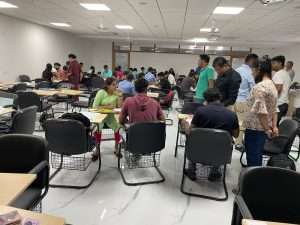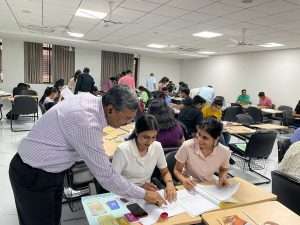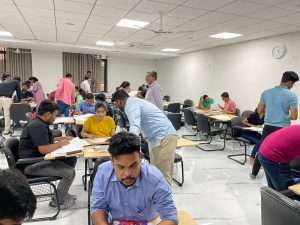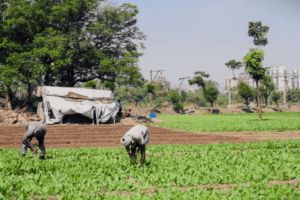The life, challenges and dilemmas faced by a typical rural Indian farmer dependent on agriculture for sustenance are an enigma for most of the students coming from an urban context to Rural Management courses. In this Blog, Prof Satyendra Nath Mishra narrates experiences from applying the Village Simulation Game to help students better understand the nuances of agrarian rural life.
CONTEXT
A new batch of two-year MBA-RM students were busy buying land, selling animals, and taking loans from the market for their agriculture operations. A few were negotiating a loan, and some others were negotiating for the lease of lands.
Surprised! Let me crack the enigma. The students were playing a simulation game and were fully engrossed in it. Most of them, born and brought up in urban environments, had never visited villages and were ignorant about the realities of rural India. Understanding and appreciating the life, challenges, and dilemma a typical rural Indian, dependent on agriculture for sustenance faces was deemed as essential for these students. With this as the objective a well-crafted Village Simulation Game was introduced as part of their orientation programme. Run by the faculty members of the school under the able guidance of Dr Rakesh Saxena, former Director of the Institute of Rural Management, Anand, the game proved to be a successful educational tool. It sensitized the city-born, convent-educated, English-speaking students of Rural Management on how agriculture-based rural economy functions, with individual households as the functional unit. This was captured well when Mr Alekhya, one of the students, shared:
“I got to know about the actual problems which are faced by the farmers practically. Their life is not easy anyway.”
Alekhya and his batch mates did get interesting, but eye-opening, insights from their two-year long journey of a field and application-oriented course.
ABOUT THE GAME
To play the game, two students are grouped (male and female preferably) together as one family unit. At the start of the game, the family members were provided with details of the number of members in their family (number, age, gender of the members, cattle, cash, and land). To facilitate the game, there are a few other actors involved as well, namely a game manager, a trader, and game inspectors. The role of the game manager is to act as the overall coordinator of the game. The game manager is also responsible for the announcement of government schemes, rainfall, pests involved, access to insurance services, and births/deaths in the family. The game is played within the annual cycle. At the end of the year, the household member must get clearance from the game manager by clearing their dues (such as fulfilling the basic needs of the family members, their livestock, bullocks, as well as loans). The trader’s role is to provide loans, agricultural inputs (seeds, high yielding varieties, fertilizer, pesticide, irrigation) and other market support, both formally and informally, to the village households. The role of the game inspector can be seen as analogous to the direct interface of state functionaries. One game inspector is responsible for facilitating the day-to-day activities of about five to six family units. The role of the game inspector includes checking the timely allocation and arrangement of all agricultural inputs (such as seeds, fertilizer, and pesticides) and ensuring the relevance of inter-household transactions between family units.

STUDENTS AND THE GAME
The game starts with allocating basic household details to family members, including land, family members, buffalos, (non) milking livestock, and some cash. Then the first-year cycle starts. For example, during the first-year cycle of the game, family members must arrange for seed, fertilizer, irrigation, and pesticide (based on preferences and needs of the family). If they do not have the requisite cash to purchase input items, they can borrow from another family (who have extra money) or from a trader. The role of the game inspector is to ensure that all these transactions are correctly noted in the first-year entry sheet. The family members must plan the agricultural activities to fulfil the mandatory food requirements of all family members (for grain and milk) and for cattle (straw from agricultural produce). The allocation of inputs involves selecting the option between ‘high yield-high risk’ versus ‘low yield-low risk’. Like high yield-high risk, options include using high-yielding variety seeds, pesticide, and fertilizer. The option of low yield-low risk includes regular seeds with no extra inputs. Multiple options exist for varying agriculture production from the allocated land. For students, this becomes a classic case of engaging with live risks and taking appropriate decisions. These options have implications for agricultural production, availability of food for family members, and feed for livestock. If the family fails to arrange for members’ food requirements, then for the next year, the game manager announces the death of the youngest member in the family or the youngest cattle. Now family members must manage their resources. They still can take a loan from traders or some other resource-rich families.

Usually, the condition changes year after year, and the family members must manage their resources themselves. The game manager maintains the input-output ratio for each year for each family on a display board. This gives family members a fair idea of how and what to explore to minimize risks and for better decision making. This interactive process, when played for three to four cycles, with different types of government and natural interventions, provide valuable insights to students about decision making and appreciation of the role farmers play while sustaining their family’s lives.

THE LEARNING
As the situation is given based on the history of any given village, it is real. The essence of the field reality was captured well by Ms. Pretty in the following words:
“I learnt how difficult it is to cultivate with few resources, unforeseen realities, and the role of barter system in farmers’ lives.”
Students could learn about the uncertainties that make agriculture activities risky for small farmers. Mr Sagar said,
“I learned about how weather conditions play a key role in crop production and the importance of optimistic decision making during the game.”
Another student Ms. Isha has a different take on the outcome. “The village stimulation game made me realize how farmers take high-risk involving decisions and how tough it gets to meet the food requirements of the family.”
The game also teaches students how to optimize, take calculated risks with minimum losses, and learn resource mobilization and conservation, and cooperation among all the players to help grow together.
Ms. Tanuja summarized her experience thus, “As the richest family in the game, I understood that you need to think before taking risks and only when one has enough reserve resources should one take risks and experiment.”
During the post-game discussion session, the feedback given by Yash and Arijeet: “Now they have come to understand that rural life is complex and there are many factors which affect farmers’ livelihoods.
They need to learn a lot before making any recommendation for farmers’ welfare or rural upliftment.” This accurately summarizes the outcome of the simulation game.
THE OUTCOME
The Dean of the School of Rural Management, Prof. Niraj Kumar, was a happy and satisfied man. He said, “If the pedagogy lets the students experience the reality, understand that lives and livelihoods are not as simple as it appears from outside, and realize that one needs to learn more and more to bring changes in farmers’ lives or to do sustainable business with rural people, our objective is met. Thus ‘The Village Simulation’ game puts our students in self-start and self-learning mode.”
 Prof. Satyendra Nath Mishra is a faculty of the School of Rural Management, XIM University, Bhubaneswar, Odisha, India. He can be reached at saty.nm@xim.edu.in
Prof. Satyendra Nath Mishra is a faculty of the School of Rural Management, XIM University, Bhubaneswar, Odisha, India. He can be reached at saty.nm@xim.edu.in





An interesting blog. The village simulation game can used as an excellent teaching resource for the faculty members teaching the courses like Rural sociology or Fundamentals of Agricultural extension. Thanking AESA for bringing out such a useful blog
Excellent, innovative teaching aid to effectively communicate to the urbanites the nuances of farmers’ struggle full life in rural settings. Worth replicating! Congratulations!